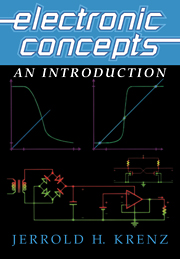Book contents
- Frontmatter
- Contents
- Preface
- 1 ELECTRONIC SYSTEMS: A CENTURY OF PROGRESS
- 2 THE SEMICONDUCTOR JUNCTION DIODE: THE BASIS OF MODERN ELECTRONICS
- 3 THE BIPOLAR JUNCTION TRANSISTOR: AN ACTIVE ELECTRONIC DEVICE
- 4 THE METAL-OXIDE FIELD-EFFECT TRANSISTOR: ANOTHER ACTIVE DEVICE
- 5 NEGATIVE FEEDBACK AND OPERATIONAL AMPLIFIERS
- 6 ELECTRONIC POWER SUPPLIES
- APPENDIX A FABRICATION OF INTEGRATED CIRCUITS
- APPENDIX B THE DESIGN PROCESS
- Index
4 - THE METAL-OXIDE FIELD-EFFECT TRANSISTOR: ANOTHER ACTIVE DEVICE
Published online by Cambridge University Press: 05 June 2012
- Frontmatter
- Contents
- Preface
- 1 ELECTRONIC SYSTEMS: A CENTURY OF PROGRESS
- 2 THE SEMICONDUCTOR JUNCTION DIODE: THE BASIS OF MODERN ELECTRONICS
- 3 THE BIPOLAR JUNCTION TRANSISTOR: AN ACTIVE ELECTRONIC DEVICE
- 4 THE METAL-OXIDE FIELD-EFFECT TRANSISTOR: ANOTHER ACTIVE DEVICE
- 5 NEGATIVE FEEDBACK AND OPERATIONAL AMPLIFIERS
- 6 ELECTRONIC POWER SUPPLIES
- APPENDIX A FABRICATION OF INTEGRATED CIRCUITS
- APPENDIX B THE DESIGN PROCESS
- Index
Summary
The idea of a field-effect transistor predates that of the junction transistor by two decades. In the late 1920s, Julius Edgar Lilienfeld proposed using an electric field to control the conductance of a semiconductor crystal (Sah 1988). Although Lilienfeld was granted three patents for proposed devices, there is no evidence that he was able to build an actual working transistor, probably because the required semiconductor technologies were not available at the time. It was Shockley's 1939 consideration of a related field-effect process, the “Schottky gate,” that initiated his thought processes and ultimately led to the invention of the point-contact transistor in 1948 (Shockley 1976). Shockley recognized that a surface field-effect played a role in the operation of this device (Shockley and Pearson 1948). Not only did the invention of the bipolar junction transistor follow this device, but so too the junction field-effect transistor (Shockley 1952).
Semiconductor field-effect devices rely on a single type of carrier for conduction, that is, either free electrons or holes. Hence, these devices are frequently referred to as unipolar transistors (single-polarity charges). The earliest commercially produced field-effect device is the junction field-effect transistor (JFET) in which conduction is controlled by a reverse-biased junction diode. This device, therefore, is characterized by a very high input resistance (negligible diode current for static conditions). Junction field-effect transistors are utilized both as discrete devices and, most frequently, in conjunction with bipolar junction transistors in integrated circuits.
- Type
- Chapter
- Information
- Electronic ConceptsAn Introduction, pp. 217 - 298Publisher: Cambridge University PressPrint publication year: 2000



